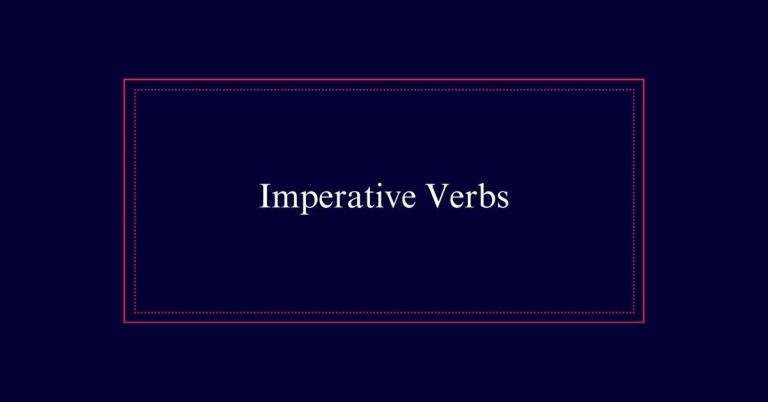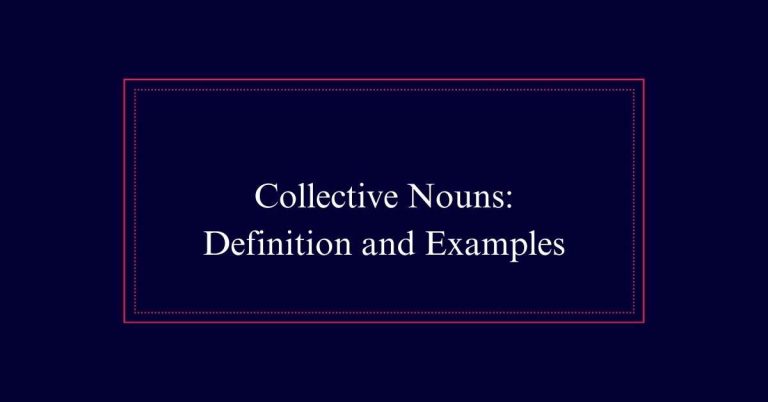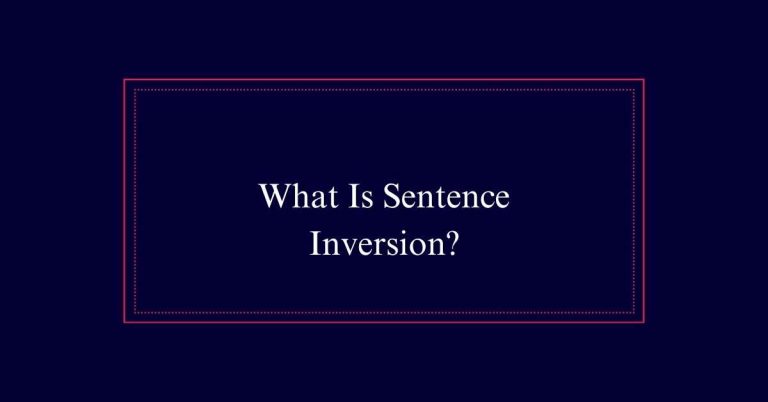What Are Split Infinitives? Meaning and Examples
A split infinitive occurs when an adverb is placed between ‘to’ and the base form of a verb. This construction, like in ‘to boldly go,’ often clarifies and emphasizes the action.
While traditional grammarians once frowned upon them, modern linguists generally accept split infinitives for their natural rhythm and readability.
Examples include ‘to not send’ and ‘to always remember.’ These structures can make sentences clearer and more engaging.
Definition of Split Infinitives
A split infinitive occurs when an adverb is placed between ‘to’ and the base form of a verb. Examples include ‘to often be’ or ‘to gradually decrease.’ Split infinitives are often used for clarity and emphasis. Most language experts agree they are acceptable and there are no grammatical rules prohibiting their use.
In many instances, a split infinitive makes a sentence easier to understand. It can also help maintain the natural rhythm and flow of a sentence. While some purists may object, modern usage generally accepts split infinitives for their ability to convey meaning more effectively and elegantly. Splitting an infinitive is sometimes preferable to avoid awkward constructions or ambiguity.
Understanding Infinitives
Understanding infinitives requires knowing that they are the base form of verbs, often preceded by ‘to’. For instance, in the phrase ‘to run,’ ‘run’ is the infinitive.
Infinitives can follow auxiliary verbs such as ‘to be’ or ‘to have.’ They serve various functions in sentences, acting as nouns, adjectives, or adverbs. When used as nouns, they can be subjects or objects. For example, in ‘To read is enjoyable,’ ‘to read’ serves as the subject.
As adjectives, they modify nouns, as in ‘a book to read.’ As adverbs, they modify verbs, adjectives, or other adverbs, such as ‘happy to help.’
Common Split Infinitives
Many common split infinitives appear in both everyday speech and written works. These constructions are often used to place emphasis or enhance clarity. For example, ‘to boldly go’ from Star Trek is a well-known split infinitive that adds a dramatic effect.
Another example is ‘to not send,’ which clearly highlights the action to be avoided. In literature, phrases like ‘to strongly, wrongly, vainly love’ by Lord Byron show how split infinitives can convey complex emotions. Even simple phrases like ‘to always remember’ are frequently encountered.
These common usages demonstrate that split infinitives are not just stylistic choices but practical tools for effective communication. They are widely accepted and often necessary for clarity and emphasis.
Acceptability of Split Infinitives
The acceptability of split infinitives has evolved over time, with modern grammarians generally viewing them as perfectly acceptable.
Historically, some traditionalists opposed split infinitives, but their stance has softened. Today, split infinitives are often recognized for their ability to enhance clarity and maintain natural rhythm in sentences.
Here are a few points to take into account:
- Historical resistance: Some older grammar guides discouraged split infinitives.
- Modern acceptance: Current grammarians find them generally acceptable.
- Practical use: Splitting infinitives can improve readability and flow.
- Reader preferences: While accepted, some readers still prefer avoiding them.
Enhancing Clarity
While modern grammarians generally accept split infinitives, their true value lies in the way they enhance clarity in writing. By placing an adverb between ‘to’ and the verb, writers can avoid ambiguity and improve readability. For example, the sentence ‘to quickly decide’ is clearer than ‘to decide quickly.’
| Example Sentence | Without Split Infinitive | With Split Infinitive |
|---|---|---|
| To quickly decide | To decide quickly | To quickly decide |
| To better understand | To understand better | To better understand |
| To fully explain | To explain fully | To fully explain |
| To clearly see | To see clearly | To clearly see |
| To gradually increase | To increase gradually | To gradually increase |
Reasons for Usage
Opting to split an infinitive can enhance clarity, preserve natural rhythm, and avoid awkward constructions. This grammatical choice is often made for several reasons, making sentences more effective and engaging.

- Clarity: Placing the adverb close to the verb helps avoid ambiguity.
- Natural Rhythm: It maintains the flow and emphasizes the intended meaning.
- Avoid Awkward Constructions: Trying to avoid split infinitives can sometimes result in stilted sentences.
- Prevent Misinterpretation: It guarantees that the adverb modifies the correct verb.
When to Avoid
Certain situations call for avoiding split infinitives to maintain clarity and elegance. While generally acceptable, split infinitives can sometimes disrupt the flow of a sentence.
If a sentence reads awkwardly due to a split infinitive, it might be best to restructure it. For instance, in formal writing or academic papers, avoiding split infinitives may align better with traditional style guides. Additionally, some readers and educators hold strong preferences against them. In these cases, rewriting the sentence can help uphold a more polished tone.
Reader Preferences
Understanding reader preferences is essential when deciding whether to use split infinitives. Different readers have varying opinions on their usage. While some find split infinitives annoying, others appreciate the clarity they can provide. Knowing your audience helps in choosing the best approach.
Consider the following factors:
- Audience Expectations: Are your readers traditionalists who might balk at split infinitives?
- Clarity: Does using a split infinitive make your sentence clearer and more understandable?
- Formality: Is your writing formal or informal? Split infinitives can be more accepted in casual writing.
- Rhythm: Does splitting the infinitive preserve the natural rhythm and flow of your sentence?
Famous Examples
Examining famous examples of split infinitives can illuminate their effectiveness and usage in different contexts. One of the most iconic is ‘to boldly go,’ from Star Trek, which emphasizes boldness.
Elizabeth Barrett Browning’s ‘to never trust’ adds emotional weight to her poetry.
NPR’s usage of ‘to not send’ guarantees clarity in communication.
Lord Byron’s ‘to strongly, wrongly, vainly love’ enhances the poetic rhythm and meaning.
Bram Stoker’s ‘to only bring’ emphasizes exclusivity in Dracula.
Summary Points
In summary, split infinitives are a versatile and often effective grammatical tool. They provide clarity and maintain a natural rhythm in writing. While some traditionalists may object, contemporary usage supports their acceptability.
Here are key points to remember:
- Clarity: Split infinitives can prevent ambiguity and ensure the intended meaning is clear.
- Rhythm: They help preserve the natural flow and emphasis of sentences.
- Flexibility: Splitting infinitives allows for more precise placement of adverbs.
- Acceptance: Most language experts agree they are grammatically correct.
Frequently Asked Questions
How Did the Controversy Over Split Infinitives Originate?
The controversy over split infinitives originated in the 19th century. Linguists sought to align English with Latin grammar rules, where infinitives cannot be split. This led to a prescriptive stance against split infinitives in English.
Are Split Infinitives Used in Other Languages?
Split infinitives are primarily an issue in English. Other languages, such as French and Spanish, do not have the same structure, so the concept of a split infinitive does not apply or cause controversy in those languages.
How Do Split Infinitives Impact Formal Writing?
Split infinitives influence formal writing by enhancing clarity, rhythm, and emphasis. They are generally acceptable and can prevent awkwardness. However, some traditionalists may prefer avoiding them. Use split infinitives when they improve readability and meaning.
Can Split Infinitives Affect the Tone of Writing?
Yes, split infinitives can affect the tone of writing. They often make sentences sound more conversational and natural. In formal writing, they can either enhance clarity or be seen as less elegant, depending on the audience.
Are There Any Famous Speeches That Use Split Infinitives?
Yes, famous speeches do use split infinitives. For instance, in Franklin D. Roosevelt’s inaugural address, he said, ‘to greatly enhance.’ This usage demonstrates that split infinitives can effectively convey emphasis and clarity.







